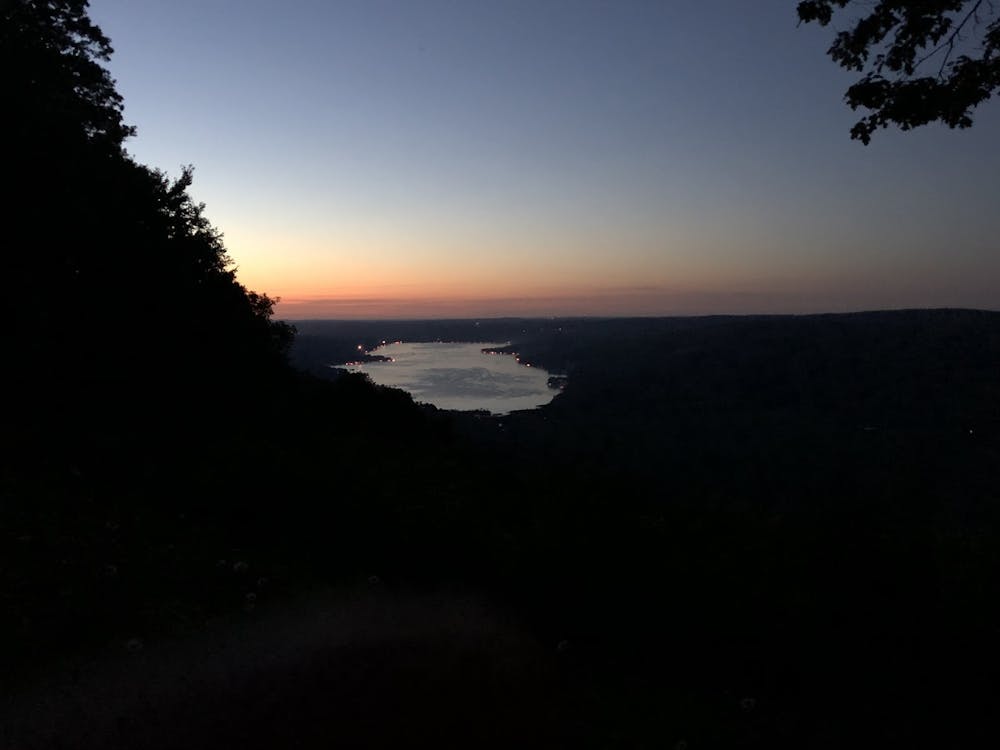Like countless towns throughout the Finger Lakes region, my small town of almost 600 people is brought together by a shared love for our lake, Honeoye. Growing up, the lake was a central part of our town: a place to go swimming, boating, fishing, water-skiing, you name it! The town’s economy once thrived during the summer, as seasonal residents and tourists would come from all over to enjoy the lake and all it had to offer. In recent years, this main economic driver and source of recreation has been threatened.
So what’s all the trouble about, you ask? Honeoye Lake, like other Finger Lakes and lakes across the state, is plagued by a dangerous microorganism called cyanobacteria, otherwise known as blue-green algae. Blue-green algae is a form of harmful algal bloom (HAB) that thrives as phosphorus levels grow in the lake, associated with fertilizer runoff from surrounding agricultural lands. Because of this, the beach is often closed early in the summer, as the toxins released by the algal blooms can pose a threat to those who come into contact with them. HABs are also known for outcompeting native aquatic plants and increasing bacterial growth in the lake. Furthermore, when blue-green algae dies, oxygen levels of the water are depleted, killing fish and other aquatic creatures.
From 2012 through the summer of 2019, over 100 HABs had been reported in Honeoye Lake. In both 2019 and 2020, the lake had 24 reports of HABs over a span of three months. This put Honeoye as the lake with the sixth highest frequency of algal blooms of 184 lakes across the state in the year 2020. However, these toxic algal blooms are not contained to Honeoye. All 11 of the Finger Lakes have been struck with outbreaks of harmful algae blooms in recent years, and over a million residents of Upstate New York depend on these lakes for drinking water. Thus, the presence of toxic algal blooms threatens not only recreation, but also the health and livelihoods of people in my hometown and beyond.
Not only are HABs a threat to human and ecosystem health, but as aforementioned, the prevalence of algal blooms over recent years has also taken a toll on the economies of Honeoye and other towns in the Finger Lakes region. Tourists and seasonal residents have always been a significant part of the local economy. However, the algal blooms have contributed to over 100 lost beach days in recent years, decreasing the touristic appeal of the town. Typically, between Memorial Day and Labor Day, between 25 and 100 percent of increases in business activity are associated with tourists and seasonal residents. Without the appeal of the lake, Honeoye fails to attract enough visitors to keep its businesses afloat.
When I was a kid, there was the annual Captain Redbeard’s Feast Pirate and Seafood Festival, which would draw as many as 3,000 people to our town to see performances, explore local artisans and vendors, listen to music, play games, and enjoy seafood. In recent years, the festival has been adjusted and outright cancelled as a result of the health concerns related to the blue-green algae. It has been several years since the last festival took place.
One major contributor to the proliferation of HABs is climate change, which warms the lake’s water. Warmer water temperatures prevent the water from mixing, permitting the algae to grow thicker and more quickly. Further, the cyanobacteria can navigate warmer waters more easily, reaching the surface faster. When at the surface, the algae absorbs incoming sunlight, heating the water even more, thus allowing more algae to grow. Drier and hotter weather, as well as pollution from local farms and residences, exacerbate the effects of blue-green algae in lakes like Honeoye.
Now, you might be wondering why anyone outside the Finger Lakes region, or even our little town, would care about microorganisms in some lake in Western New York. I mean, you probably don’t own the farms whose fertilizer runoff put enough phosphorus in the lake for harmful algal blooms to thrive. And honestly, how likely is it that you actually will visit or live in the Finger Lakes region in your life?
These are fair points, I’ll admit. But I implore you to consider the ways in which climate change is exacerbating environmental issues in your hometown, whether noticeably or more subtly, like in my community. The impacts of climate change are not isolated, one-off events. They are not limited to hurricanes in the Gulf, or wildfires in the West, or melting ice caps in the Arctic. Climate change is not some distant, imminent issue that our grandchildren will have to live with. Climate change is an issue that requires urgent, immediate action.

This Earth Day, Princeton has yet to divest from the fossil fuel industry, continues to take environmental research funding from companies that have funded climate denial and disinformation programs, and has been otherwise slow to act.
I don’t write to gain sympathy for the devastating health and economic impacts of harmful algal blooms experienced by my town. I write this as a reminder of Princeton’s negligence and complacency in the climate crisis, as a reminder that even those within the Orange Bubble are not safe. I write this with the hopes that Princeton will choose to stand on the right side of history moving forward, rather than continuing to invest in an industry that threatens not only our futures, but also our present health and well-being.
Hannah Reynolds is a junior in the anthropology department from Upstate N.Y. She can be reached at hannahr@princeton.edu.









